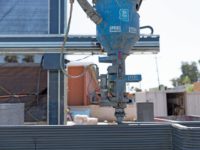"Historically, the changes from year to year in overall material prices have been in line with general inflation. However, in the last 10 years, this has not been the case," says Alison Black, ARTBA's chief economist. "This has impacted the real market for highway and bridge construction in an economic environment where state and local governments are facing extreme budget challenges and trying to make their dollars go further."
MIT's work is drawing scrutiny partly because of its funding source: cement companies. "What the industry does with our results, that's the industry. You are not hearing that from us," comments Franz-Josef Ulm, a materials scientist who leads MIT's Hub research. "This is not about asphalt vs. concrete but about opportunities to unleash the innovation potential of sustainable development."
The Hub has been involved in other public policy debates. In September 2010, Ulm wrote a letter to OMB Administrator Cass R. Sunstein expressing concern about coal-ash regulations brewing at the Environmental Protection Agency (ENR 4/12/10 p. 12). Because fly ash, a by-product of burning coal, can be cut into cement to lower concrete's costs and carbon footprint, supporters fear that labeling coal ash a hazardous material will effectively ban its use through industrial stigma—the industry's next asbestos. Environmentalists who support the regulation say the toxins in coal ash are far more concentrated than in the past and oppose continuing one dirty process to make another one greener.
Over time, the energy needed to use buildings and roads contributes more to global warming than their initial construction. But more fly ash can greatly reduce their footprint, says MIT. "Our researchers at [the Hub] have identified coal fly ash as one possible game changer that could significantly reduce the current environmental footprint of the national cement and concrete production," Ulm's letter says. "I am greatly concerned that if fly ash were to be classified as a hazardous material, it will hamper beneficial use just at a time [when] we are on the scientific brink of greatly increasing it to help achieve our sustainability goals." EPA is reviewing public comments on the regulation, the potential cost of which is not included in MIT's life-cycle estimates. Fly-ash concentrations in concrete average between 10% and 15%, but MIT proposes at least doubling it. ARTBA predicts the regulation could increase transportation construction costs by $104.6 billion over the next 20 years.
Despite the criticism, Ulm defends MIT's work. "Academia is—and must be—always ahead of the status quo and develop new science-based methods irrespective of industry interests," he says.
The Hub was formally established in 2009 to delve into the carbon issue. Deep-well driller Schlumberger has MIT looking into setting issues related to deepwater cements. The U.S. Army Corps of Engineers is funding a study on blast resistance. The Hub studies other porous substances, such as nuclear fuel and shale gas. Some 30 teachers and students at MIT's Dept. of Civil and Environmental Engineering are on the team.
The main charge, researchers say, is to define concrete from the bottom up. "The battle cry of material science is to understand microstructure," says Hamlin Jennings, a cement scientist and the Hub's executive director. "By understanding microstructure, we learn how to manipulate that structure and understand how that structure controls properties."
In the past, concrete research focused on top-down methods. Even the most sophisticated microscopes cannot parse cement's atoms, which scientists once thought were frozen in a crystalline arrangement. Now they think cement behaves more like a glass, slowly creeping and shrinking over time.
In 2007, Jennings detailed a nanoscale model of portland cement's main ingredient: calcium-silicate-hydrate (ENR 4/16/07 p. 12). The acronym for the Concrete Sustainability Hub is a play on words, as C-S-H makes cement work. Portland cement is energy-intensive, so it is carbon-intensive. Producers make it by heating up limestone, clay and sand to 2,700°F. A kiln turns the material into "clinker," or calcium silicate. The process yields equal parts of cement and carbon dioxide. While roughly half the emissions are due to calcination, the rest are due to the energy firing the intense heat. In 2010, 3.1 billion tons of cement were produced globally, which translates into about 20 billion tons of concrete, Ulm estimates. Interestingly, concrete recaptures some carbon as it ages, which mitigates its impact.
MIT has calculated the life-cycle contribution of calcination, carbonation and other variables in two other studies, ">released last August. One focuses on buildings, the other on pavements.




